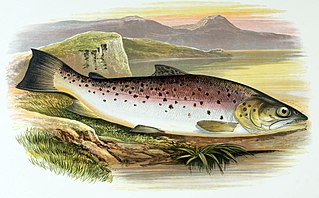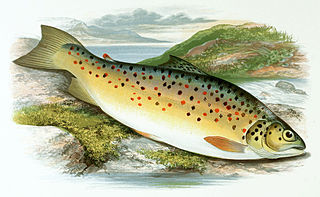
Trout is a generic common name for numerous species of carnivorous freshwater ray-finned fishes belonging to the genera Oncorhynchus, Salmo and Salvelinus, all of which are members of the subfamily Salmoninae in the family Salmonidae. The word trout is also used for some similar-shaped but non-salmonid fish, such as the spotted seatrout/speckled trout.

The brown trout is a species of salmonid ray-finned fish and the most widely distributed species of the genus Salmo, endemic to most of Europe, West Asia and parts of North Africa, and has been widely introduced globally as a game fish, even becoming one of the world's worst invasive species outside of its native range.

Salmo is a genus of ray-finned fish from the subfamily Salmoninae of family Salmonidae, and is part of the tribe Salmonini along with the sister genera Salvelinus and Salvethymus. Almost all Salmo species are native only in the Old World, the only exception being the Atlantic salmon, which is also naturally found across the North Atlantic in eastern North America.

The Atlantic salmon is a species of ray-finned fish in the family Salmonidae. It is the third largest of the Salmonidae, behind Siberian taimen and Pacific Chinook salmon, growing up to a meter in length. Atlantic salmon are found in the northern Atlantic Ocean and in rivers that flow into it. Most populations are anadromous, hatching in streams and rivers but moving out to sea as they grow where they mature, after which the adults seasonally move upstream again to spawn.

The Arctic char or Arctic charr is a cold-water fish in the family Salmonidae, native to alpine lakes, as well as Arctic and subarctic coastal waters in the Holarctic.

Sea trout is the common name usually applied to anadromous (sea-run) forms of brown trout, and is often referred to as Salmo trutta morpha trutta. Other names for anadromous brown trout are bull trout, sewin (Wales), peel or peal, mort, finnock (Scotland), white trout (Ireland), Dollaghan and salmon trout (culinary).

Oncorhynchus is a genus of ray-finned fish in the subfamily Salmoninae of the family Salmonidae, native to coldwater tributaries of the North Pacific basin. The genus contains twelve extant species, namely six species of Pacific salmon and six species of Pacific trout, all of which are migratory mid-level predatory fish that display natal homing and semelparity.

Salvelinus is a genus of salmonid fish often called char or charr; some species are called "trout". Salvelinus is a member of the subfamily Salmoninae within the family Salmonidae. The genus has a northern circumpolar distribution, and most of its members are typically cold-water fish that primarily inhabit fresh waters. Many species also migrate to the sea.

Ferox trout is a variety of trout found in oligotrophic lakes/lochs of Ireland, England, Scotland and Wales. Ferox trout is a traditional name for large, piscivorous trout, which in Scotland feed largely on Arctic char. It has been argued to be a distinct species, being reproductively isolated from "normal" brown trout of the same lakes, particularly in Ireland. However, it is uncertain whether the ferox of different lakes are all of a single origin. This fish grows to a length of 80 centimetres (31 in) SL.

The Sevan trout is an endemic fish species of Lake Sevan in Armenia, known as ishkhan in Armenian. It is a salmonid fish related to the brown trout.

The gillaroo is a species of trout which eats primarily snails and is only proven to inhabit Lough Melvin in Ireland.

Salmo obtusirostris, commonly known as the softmouth trout, also known as the Adriatic trout, or Adriatic salmon, is a species of salmonid fish endemic to a handful rivers spilling into Adriatic in the Western Balkans, in southeastern Europe, namely in Bosnia and Herzegovina, Croatia and Montenegro. The scientific name has changed several times through history; synonyms include Thymallus microlepis, Salmothymus obtusirostris and Salar obtusirostris.

Ohrid trout or the Lake Ohrid brown trout is an endemic species of trout in Lake Ohrid and in its tributaries and outlet, the Black Drin river, in North Macedonia and Albania. Locally, the fish is known as охридска пастрмка in Macedonian and Koran or Korani in Albanian.

Salmo carpio, also known as the carpione is a salmonid fish endemic to Lake Garda in Italy. It has been introduced to a number of other lakes in Italy and elsewhere but unsuccessfully in all cases. The population in Lake Garda has been strongly declining, and is considered critically endangered. The main threats are due to overfishing, pollution and possibly competition from introduced species such as Coregonus and other Salmonidae.
Salmo fibreni, or the Fibreno trout, is a freshwater salmonid fish, endemic to Lago di Posta Fibreno in central Italy.
Salmo ezenami is a critically endangered freshwater salmonid fish, endemic to Lake Kezenoi-Am in Northern Caucasus.
The fish fauna of the Neretva river basin in the western Balkans is representative of the Dinaric karst region and characterized by several endemic and endangered species.
Salmo rhodanensis, or the Rhône trout, is a salmonid fish, a putative species of trout resident in the Rhône river drainage in France and Switzerland. It was previously considered as belonging to Salmo trutta. Salmo rhodanensis is an exclusively freshwater fish, and is uniquely characterized by four broad black bars on its body: behind gill opening, under dorsal base, above anal fin origin, and at the base of the tail.

Salvelinus grayi, also called Gray's char[r], Lough Melvin char[r] or freshwater herring, is a species of lacustrine char in the family Salmonidae.
Salmo nigripinnis, also known as the sonaghen, is a species of fish within the family Salmoninae.















